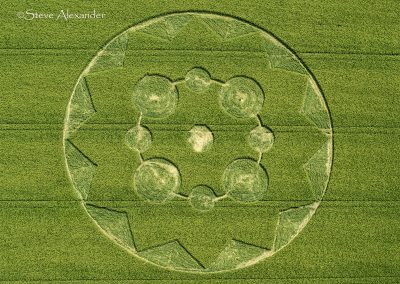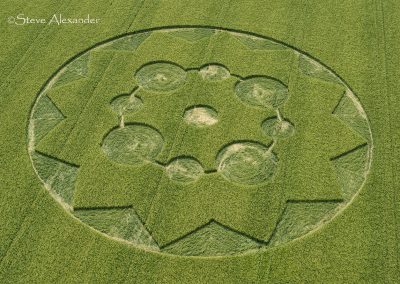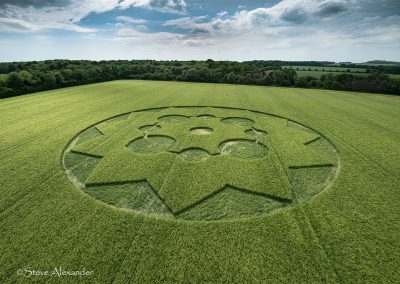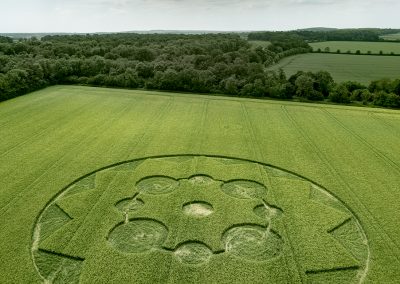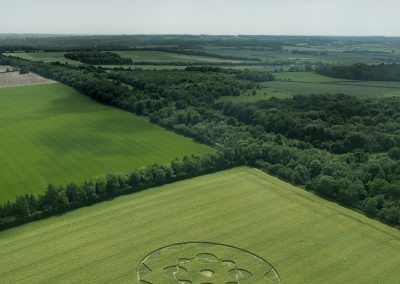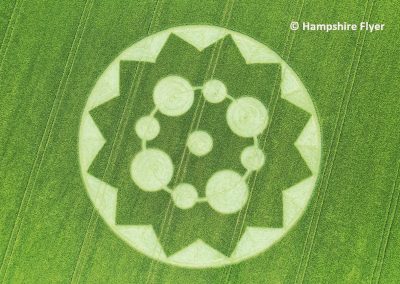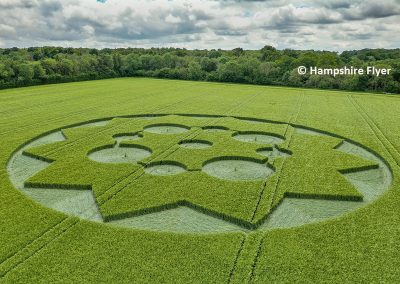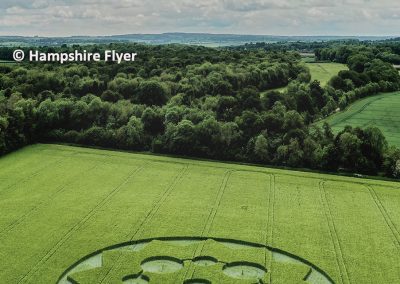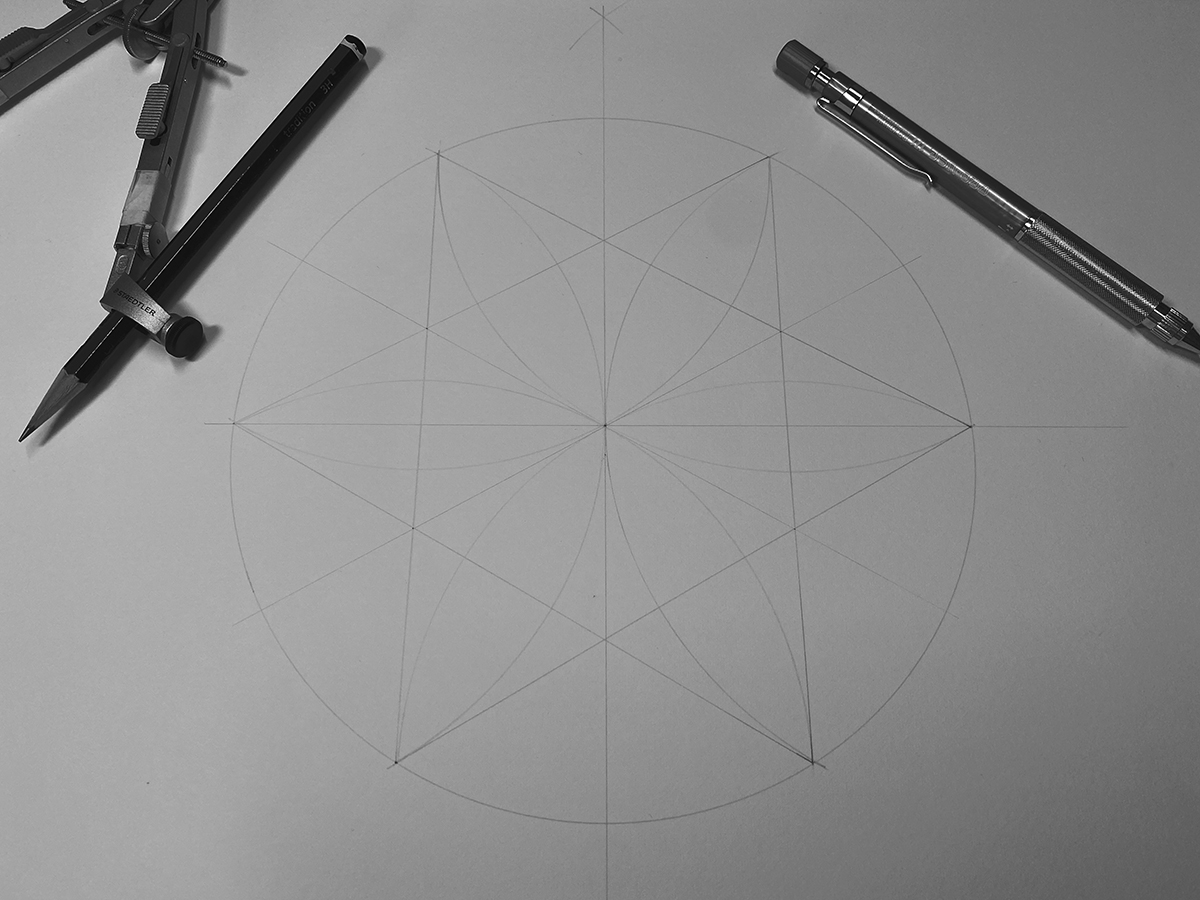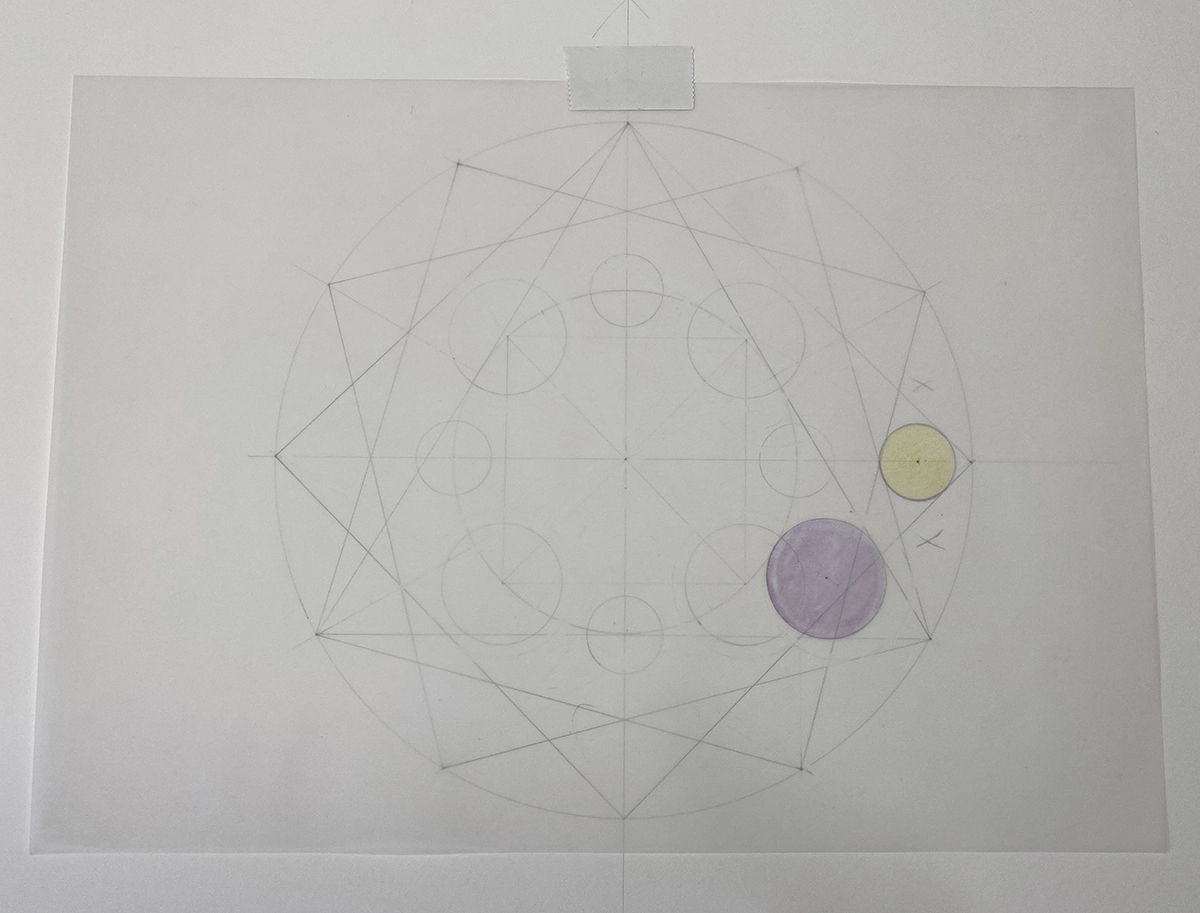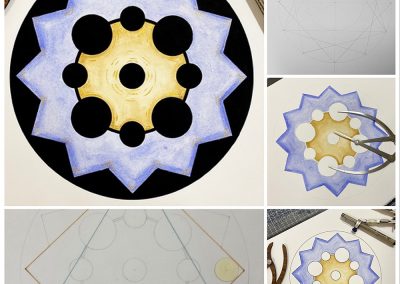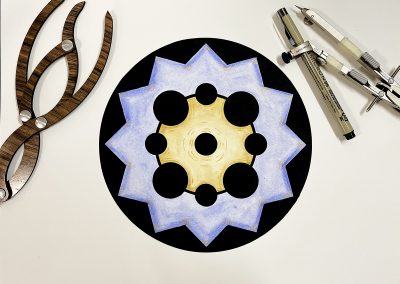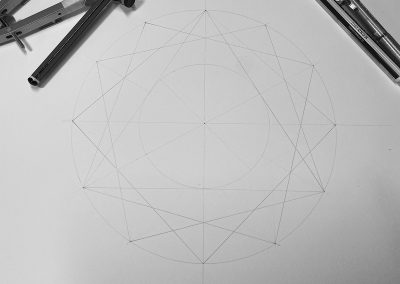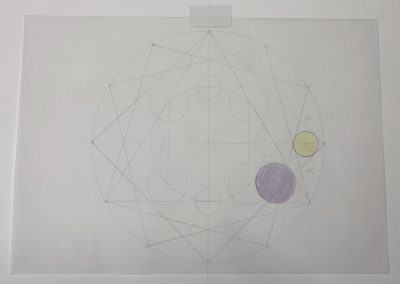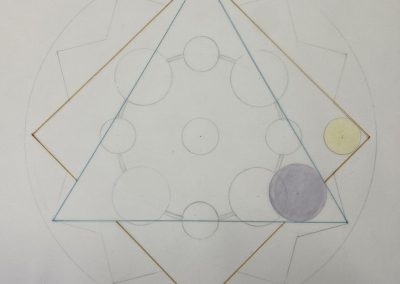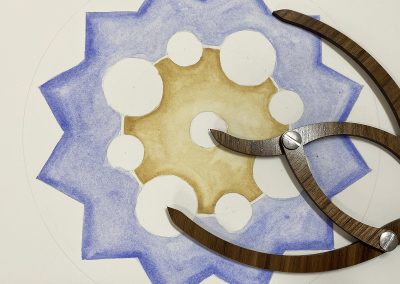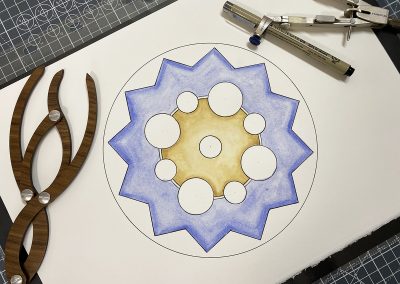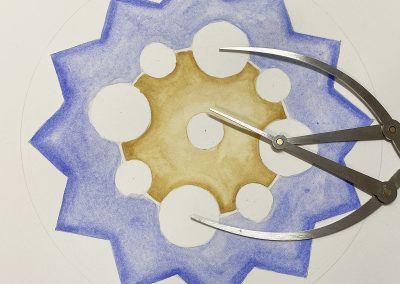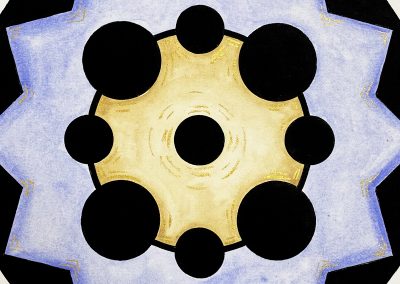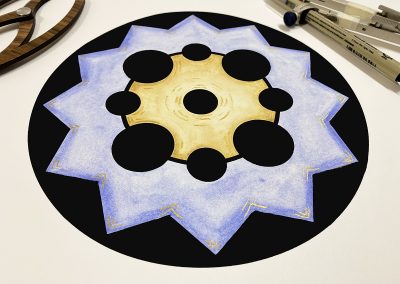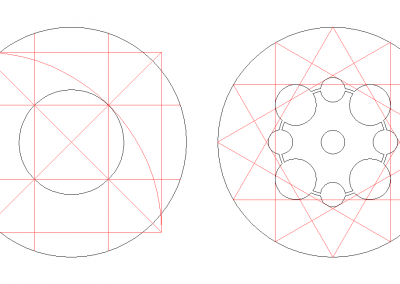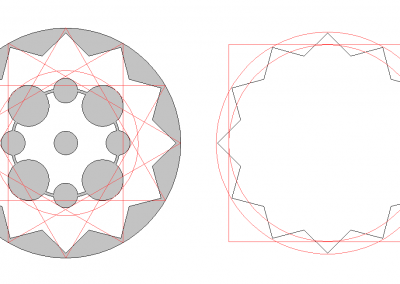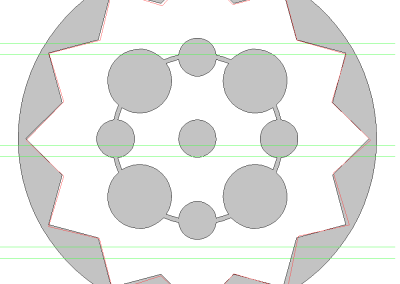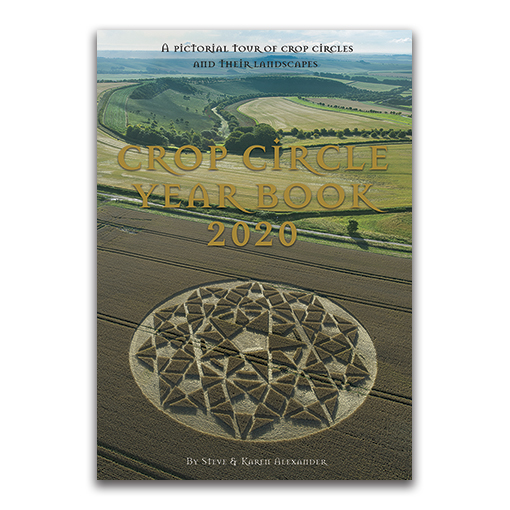Crawley Down, nr South Wonston, Hants.
(between Sutton Scotney and South Wonston)
Detail & Location: This circle was reported on the 8th of June. It is in a field of Barley and measures approximately 250ft in diameter. It is close to Crawley Down and next to Barton Stacey Belt – a strip of trees that lies beside the A272. See the Google Maps link for precise location.
Crop Circle Reporting and Covid-19: As in 2020, we will not be censoring crop circle locations during the continuing Covid-19 pandemic. We consider the reporting of crop circles to be in the spirit of journalism, and censorship to be an anathema to that spirit. Therefore, we will be treating the crop circle community as adults and asking everyone to approach the information carefully and responsibly. This will include not visiting the circles if the farmer has not given explicit permission to do so and should permission be given adhering to any covid restrictions in place.
Flying during the Covid-19 Pandemic: The UK is coming out of covid restrictions in the UK during the early summer of 2021. However, the restrictions of the past year have had a heavy impact on the aviation industry. Flying will continue to be very challenging for us this year, with access to aircraft and pilots still very restricted. We will continue to cover the season, flying where we can, while continuing to work photographer colleagues to bring you as much coverage as we can. We’d like to extend our deep gratitude to all those who generously share their images with us.
Visiting: As far as we are aware no permission has been given to visit this crop circle. Please do not visit this circle. Thank you.
History & Connections: This area of Hampshire is replete with ancient sites. Norsebury Ring earthwork lies close-by as does the South Wonston Barrow Cemetery and Longbarrow. You can see a picture of Norsebury Ring here. It’s located to the North-East of the crop circle.
Design & Symbolism: This is a very well made 12-fold star (of the three square variety), with a double quintuplet at its centre. We will have more to say about its geometry and design very soon. See the Geometry Gallery below for updates as we have them.
Visiting the Circles? If you are thinking of visiting any crop circles this summer, please read our Visiting the Crop Circles section. It’s full of useful information and etiquette for visiting the countryside and the crop circles. Please remember that you should not enter any fields without the express permission of the farmer and you will need to be aware of and abide by any restrictions in place in the UK in response to the Covid-19 pandemic.
Click here for Copyright Information about the reproduction of images on this website.
Please Help to keep us Flying in 2021: If you have enjoyed looking at our pictures and information please consider making a small donation to keep us flying. There are so few of us left regularly recording the circles it’s really important that we continue. And while some now use drones to record the circles, it is important that there are still images taken from aircraft where the best quality camera equipment can be used and images that include the broad vista of the landscape can be taken. This kind of photography is expensive and it gets harder with each passing year to raise the funds we need to continue our work, but if everyone who regularly looked at this website made a small donation we would meet the funds we need. You can make a donation here.
NOTE: Some of the images below are beautiful landscape scenes. Click on each image to enlarge them and see the whole picture.
IMPORTANT THANKS: to Hampshire Flyer for allowing us to use his images on our website.
Image Licencing
We can supply high resolution images of many of our photographs and the sky is the limit as to what they can be used for! Choose from our extensive library or contact us to commission aerial photography for your project.
Geometry Gallery
Square, Circle, Triangle (part 2)
The Crop Circle at South Wonston, 2021
by Karen Alexander
At the end of the 2019 season I wrote a blog about the Preston Candover crop circle of that year entitled ‘Square, Circle, Triangle’ in which I discussed the seminal nature of these forms. I opened the blog with this quote from Galileo Galilei and it’s worth repeating here. For those of you who have’t seen it, it might be worth your time looking at it, because the same three shapes are also at work in the South Wonston crop circle.
“Philosophy is written in this grand book – I mean the Universe – which stands continually open to our gaze, but it cannot be understood unless one first learns to interpret the characters. It is the language of mathematics and its characters are triangles, circles, and other geometrical figures, without which, it is humanly impossible to understand a single word of it; without these, one is wandering around in a dark labyrinth”. Galileo Galilei
 Shut-up and Take Note!
Shut-up and Take Note!
The magnificent crop circle that appeared at South Wonston in June 2021 was an incredible visual statement. It had presence, power and the kind of authority, that made you want to shut up and take note!
Eternal Characters of the Cosmos
Crop Circles can be incredibly visually arresting, but each has their own individual style. Each seems to have a feeling to them - lightness, delicacy, complexity, harmony, symmetry, beauty etc. It’s incredible when you stop to think about it, that a crop circle can evoke such feeling. And yet, this is their body, mythos and language, as Galileo said, geometric figures are the eternal characters of the Cosmos. They give order to chaos, they form harmony, symmetry and sometimes, even dissonance and atonality, all while generating the grand tapestry of all that is.
Being in the presence of a crop circle is not something to undertake ignorantly. A good friend of mine from the ‘old days’ of the phenomenon, would always silently ask for permission to enter the circle as he walked up the tractor lines, I often find myself doing the same - a little humility in the face of such things never goes a miss. It’s a way to just check oneself, prepare and centre oneself for the experience ahead.
The Power of the 12-pointed Star
Part of the particular impact of this crop formation is the huge 12-fold star that dominates this design. It struck me as a thing quite rare to have such a large shape preside over a design like this. Its power comes from the fact that this star is a very large standing element in the design, as such it has adds solidity, weight, and a sheer heft to the whole design.
I remember asking the late and very-great writer John Anthony West, why he thought the Ancient Egyptians built their greatest constructions using such impossibly large blocks of stone? He said, without hesitation, ‘big stones; big power’. There is some of this when it comes to the crop circles too. The 12-pointed star in this formation was akin to using an impossibly large block of stone - it commanded great presence and power.
Hospitality Portals?
The next thing that struck me about this crop circle was the absence of what the late crop circle researcher Michael Glickman called ‘Hospitality Portals’. By this he meant those gaps in the geometry of the formation that allow access to all parts of the design for the visitor. Typically in most crop circles, the geometry is arranged in such a way as to create a walking route throughout the design. This means that not only can visitors experience the whole design, they can do so without further damaging the crop - i.e. there is no need to further trample the standing crop. Michael considered that this told us something important about the phenomenon - that it had a fundamental respect for life - animal or vegetable.
These gaps were totally absent in the South Wonston circle. Access to the formation was granted by the tractor lines that crossed the crop circle. This is unusual, but not unique. In fact there have been times when even with the tractor lines in the field, certain parts of circles have been inaccessible without trampling the crop. Like Michael (and many others), I think these areas are not for us - they should remain inviolate. It’s a great test of character, can you stay out, would you even think before ploughing in mindlessly? Many have failed the test.
The Double Quintuplet
Inside the standing 12-pointed star was placed a double-quintuplet design (4 equidistant circles around a central 5th), this pattern goes back to the earliest days of the modern phenomenon, barely a year goes by without it reoccurring, either on its own, or as part of a bigger design. It has been part of the human canon of sacred design for millennia, it is used in sacred buildings all over the world where it is known as ‘ad quadratum’ and features in many Cosmati designs - notably in the great ‘Cosmati Pavement’ in Westminster Abbey. The four elements centred around a central quintessence (5), is an eloquent symbol for the Cosmos.
Squaring the Circle Any of you familiar with crop circle history will know that (as shown in the work of geometer Allan Brown) almost without exception, all quintuplets in crop circle design ‘square the circle’. In other words they contain in their geometry a circle and a square whose area or perimeter are equal (or as near as damn it). This is significant because the marriage of the circle and square in this manner creates symbolic sacred space. If the circle symbolises Unity, the Divine or Heavenly realm, then the square represents, the Earth, matter, mother substance. The marriage of the two, brings the Divine down to the Earth - it’s the reason so many scared buildings feature a square with a dome on the top. That this happens so ubiquitously in the designs of the crop circles may also suggest something about the nature of the phenomenon (or its philosophy at least) - along with its respect for life.
Drawing the South Wonston Crop Circle
To draw, to recreate a crop circle on paper, is to also actively participate in the creative act of the formation itself. While we might never know the order in which the design was originally created (if indeed it doesn’t happen all at once), it does give great insight into the pattern itself.
This circle begins with a division of the circle into12. There are several ways to do this using compass and straight edge, rather than a protractor, which is considered taboo in sacred geometry. I chose a simple seed-of-life design, followed by a hexagram to create the additional six intersections.
Whether by design, or default, this particular 12-pointed star can be drawn using three squares. So already we have a containing circle and then three squares.
The question of 24?
There is a question mark over whether division by 24 could be used to create this formation. I looked at this and yes, it could be done. It might even be said to be fitting in this case, namely because 24 could be seen as a number that is related to both 12 and 8 (it could be seen as a bridge between the two). But strictly speaking, it isn’t necessary. But this question does lead on to the issue of self-generating geometry versus arbitrary measure. To use division by 24 would mean the employment of an arbitrary measure to create the star.
Self-generating geometry vs. arbitrary measure.
Many students of Sacred Geometry often find themselves drawn to the crop circles. The geometry of the crop circles is often innovative and novel, attracting those with a penchant for ratio and proportion.
But it is important to point out that the two subjects are not one and the same. Of course, there is plenty of cross-over, hence the attraction, but it would be an error to say that all crop circles contain classical Sacred Geometry. Some clearly do, and some clearly don’t. And while it might be argued that those that do are often the most satisfying to draw and explore, it would be rather harsh, and plainly not true to suggest that anything that lies outside the classical tradition is somehow just bad design. Crop Circles are ‘pictogramatic’ if one will excuse the word (which in fact I’m pretty sure I just made up), they are image lead, rather than geometry lead. The Alien Face of 2002 (amongst many others) is a great case in point. Personally, I love those with a classical geometrical construction. But I don’t automatically dismiss the others.
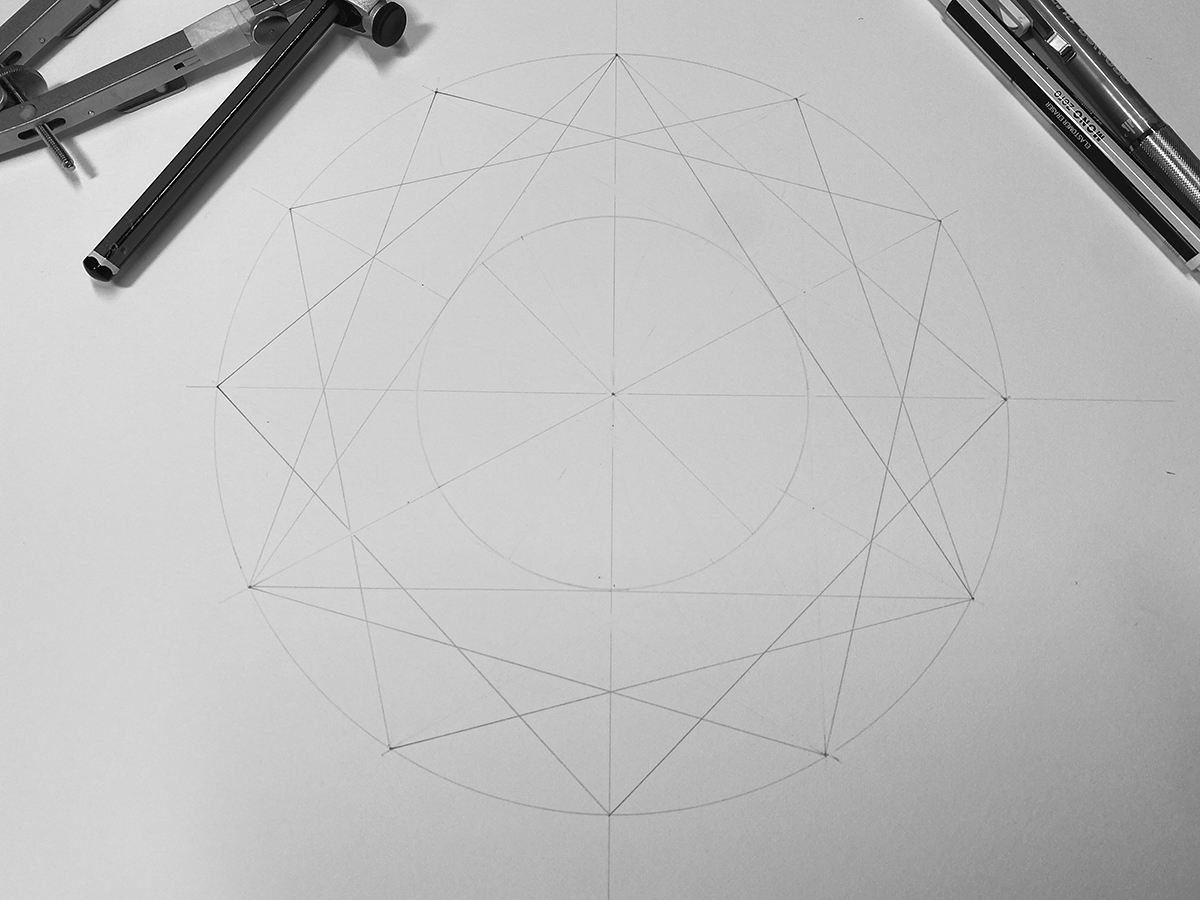
A triangle sits in the decagram: a circle inscribed within it defines the ring of the double-quintuplet.
The circle of the double-quintuplet
The next question when drawing this circle is how to determine the diameter of the ring upon which the eight smaller circles sit in the double-quintuplet pattern. A circle drawn within a triangle drawn within the 12-pointed star, does the job. So here we finally have our Square, Circle and Triangle (of the title of this blog). The smaller circles are of two diameters, one smaller, one larger, these are also each defined by a circle and a triangle. See Illustration. This is self-generating geometry at its best. There is no need for any arbitrary measure at all. Everything is generated from the geometry present.
The Qualities of 12 & 8
As always, when looking at the design of a crop circles, one looks at the qualities of the numbers involved. This isn’t numerology, it isn’t number association derived from mere tradition or magical thought. The qualities of numbers are derived from observation of the way they behave in, and correspond to, nature. It is one of the oldest scientific practices. The extraordinary architect, teacher and geometer Keith Critchlow called the drawing compass the most scientific instrument ever invented by man. I can see his point.
Twelve is a number linked to time, measure and wholeness. The reasons for this are obvious, Once upon a time, both time and measure were linked through the imperial measurement system - which used base 12. This was important because it linked measure to time and to the cosmos. It took the rotation of the Earth and built a system of measure upon it. For our ancestors this was essential, because it linked our everyday lives to that of the heavens - as the mathematician and geometer Michael Schneider says, in doing this mankind was in essence breathing as one with the cosmos. If you ever needed proof that this ancient system was part of a universal language of number and symbol - this one is pretty good
Eight is a number that can be linked to time in a different way - through sound. Music is number and ratio in time. Eight is also one of the most promiscuous numbers in the decad (numbers 1-10), it interacts and harmonises naturally with more numbers than any other - one reason we use eight binary bits in a byte in computing. It is also the first cubic number, i.e it introduces depth, to both length and width. However, eight is also a number associated with ‘attaining/accessing a new level’. As I’ve no doubt said many time on this website, when you play the seven notes of the musical scale, it is not until one sounds the octave that the sequence feels complete - and one finds ones self back at the beginning, yet simultaneously somewhere new.
Bringing it all together
Anyone looking at this crop circle and thinking it was pretty simple, would be clearly mistaken. When my old pal Michael Glickman would tell his audiences to 'stare at the crop circles until your foreheads bleed’ he was of course being ironic, but he was also making a serious point. In our world of immediate information, social media and instant gratification, we are forgetting how to look, we take the time to notice nothing but the obvious - it is to our detriment that we do so.
In this crop circle we have found, the circle, the square and the triangle. The circle represents something ineffable and unified. The square, something rooted in matter - in this circle, there are three squares that make up the 12-pointed star - so this is matter in 3-iterations (or dimensions). Of all the shapes, the triangle is the most hidden, the triangle is the symbol of spirit - something you can’t see, yet is at the heart of all life.
The double- quintuplet is a symbol for a deepening cosmos (Cosmati/Cosmatique). The doubling also echoes the idea of unseen dimensions at work in our reality, or a more complex view of reality developing at the heart of this formation. Twelve, once again echoes wholeness, but also that idea of breathing with the cosmos - of a re-alignment of our culture in context of a larger and more complex reality. And finally eight, stepping up a scale (or level), feeling we are back at the beginning, yet being simultaneously at the threshold of something new.
Finally, I discovered several Phi proportions in this formations - I've included a couple in the gallery below. Phi, the proportioner of all living things, is yet another suggestive motif as to the mature of this phenomenon.
The Gift is the Language
Like the movie Arrival, the gift of the crop circles is in their language. To think in this highly symbolic, metaphoric, yet utterly scientific way, might feel like a step backwards. But our ancestors knew a thing or two - they knew how to breathe in time with cosmos. If we ever want to be part of a larger cosmic community, we must learn to do this again. I found this link with breath, in both of the first circles of 2021, to be utterly fascinating. I saw a new vision (a more complex vision) of the cosmos, nestled in the heart of the spirit, one in which our hearts are aligned and unified in time with the breath of the cosmos.
Please enjoy the images in the gallery below.
Text | Hand-drawn Images by Karen Alexander.
Further Notes:
Researcher Peter van den Burg found a different way for placing the quintuplet inside the 12-pointed star by placing an eight-pointed star on top of the dodecagram. He also found that the double quintuplet does in fact square the circle. See his drawings in the gallery below for more information.
Thanks/Credits:
I would like to thank some of my crop circle cognoscenti for their help in forming these ideas: Steve Alexander, Peter van den Burg, Albert Lamb and Jonathan-Paul DeVierville.
With special thanks to Peter van den Burg for his thoughts, perspectives and analysis. You can see more of his great work on his Facebook page Geometry of the crop circles.
Golden Section Proportioners by Scott Onstott.
Further Reading: Square, Circle, Triangle by Bruno Munari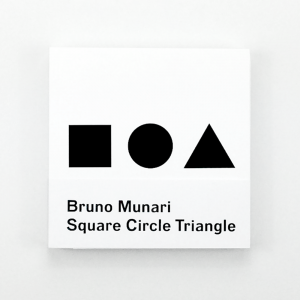
- Paperback: 280 pages
- Publisher: Princeton Architectural Press
- Language: English
- ISBN-10: 1616894121
- ISBN-13: 978-1616894122
Date
08.06.2021
Crop
Barley
Visiting
No permission has been given to enter this circle.
Google Maps Link


